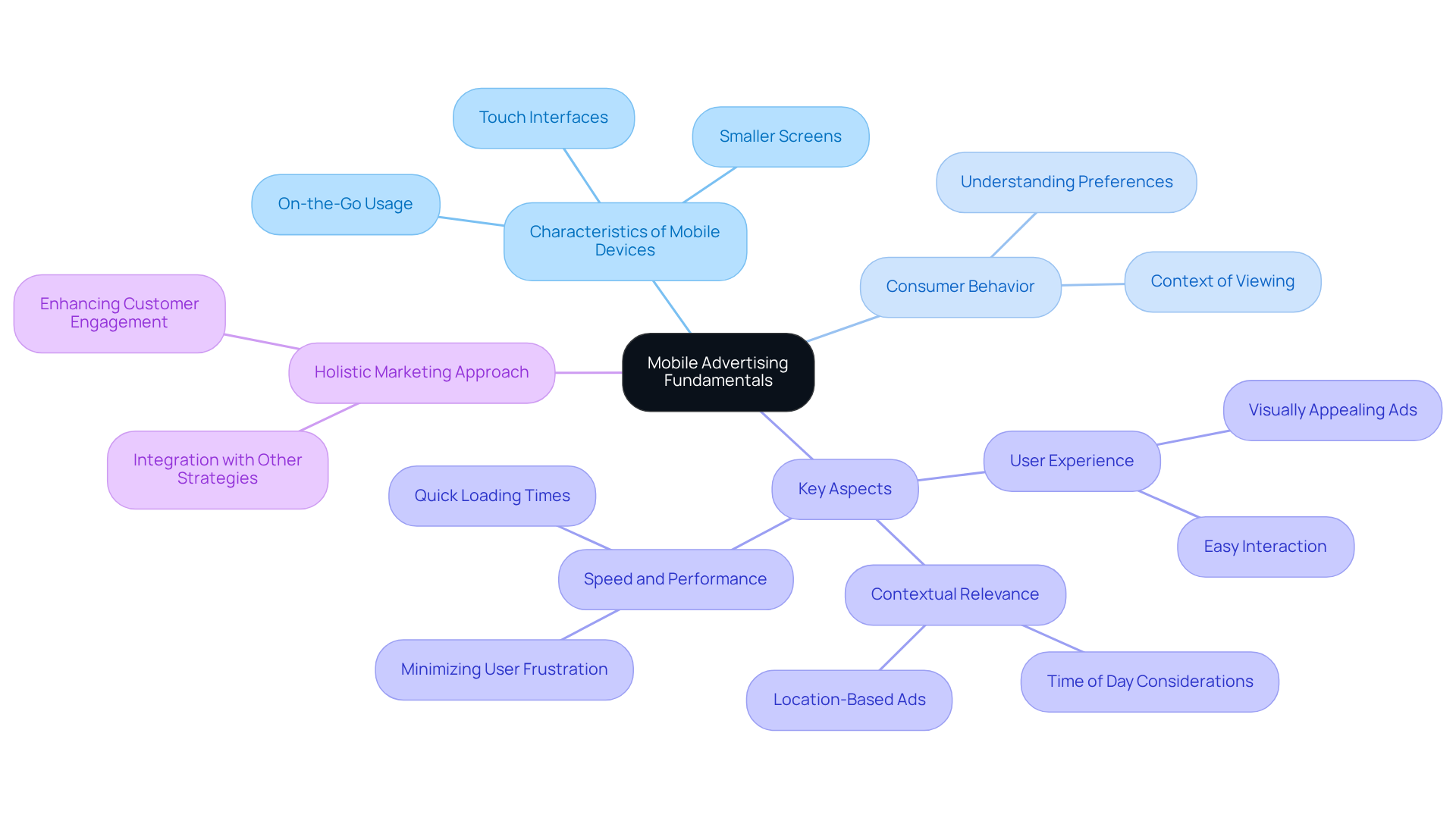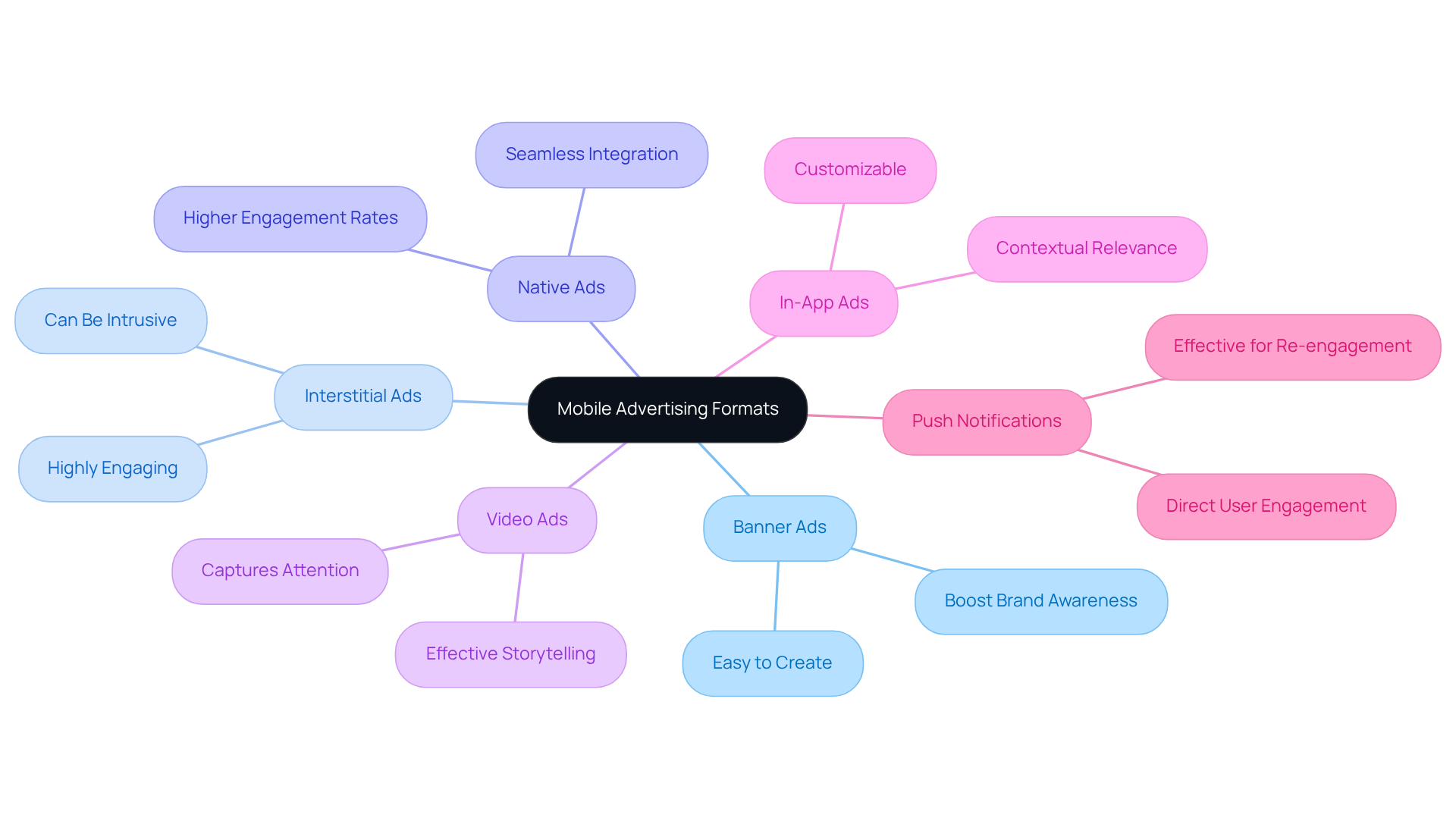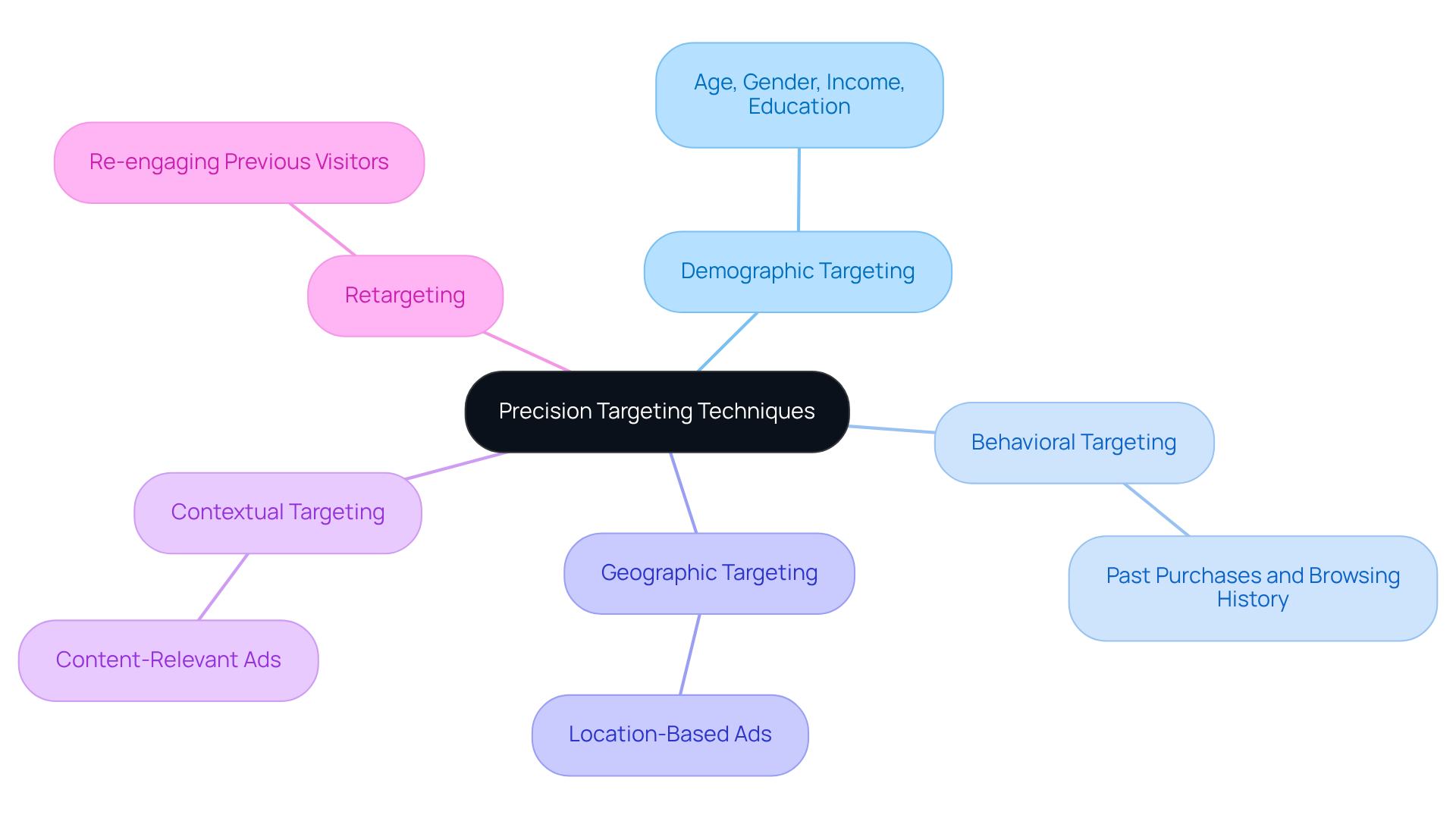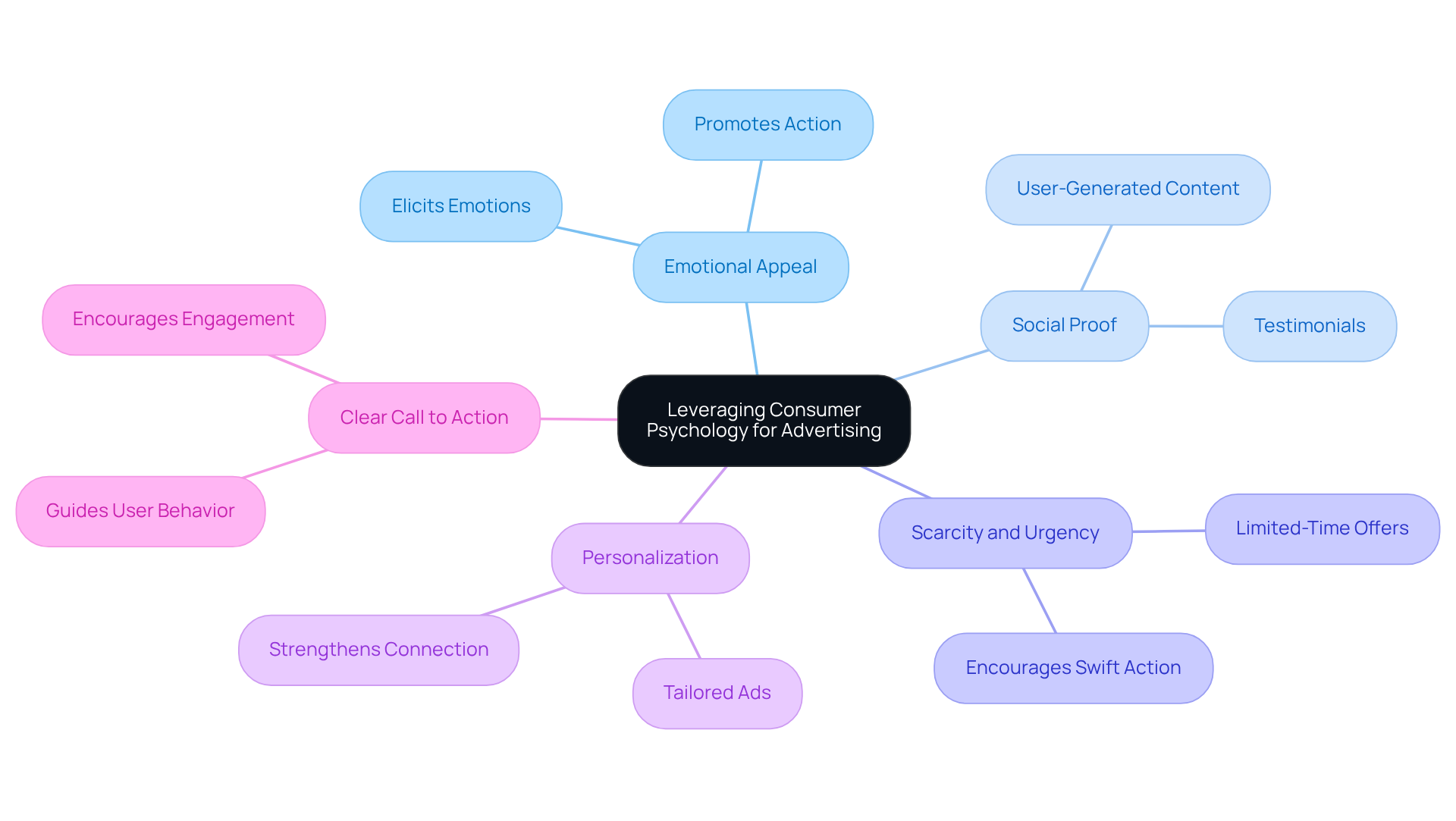
Overview
Effective cell phone advertising is crucial for direct-to-consumer (DTC) brands. To excel in this competitive landscape, brands must adopt five best practices that not only enhance engagement but also drive conversions and foster customer loyalty.
-
Understanding mobile advertising fundamentals is essential. This knowledge lays the groundwork for leveraging various ad formats effectively. From video ads to interactive content, each format serves a unique purpose in capturing consumer attention.
-
Precision targeting cannot be overlooked. By honing in on specific demographics and user behaviors, DTC brands can ensure their messages reach the right audience at the right time. This targeted approach significantly increases the likelihood of engagement and conversion.
-
Measuring success through key performance indicators (KPIs) is another critical practice. By analyzing metrics such as click-through rates and conversion rates, brands can assess the effectiveness of their campaigns and make data-driven adjustments.
-
Utilizing consumer psychology plays a pivotal role in enhancing engagement. Understanding what motivates consumers allows brands to craft messages that resonate on a deeper level, ultimately leading to stronger connections and loyalty.
-
These practices are not just theoretical; they are backed by strategic insights into user behavior and preferences. By implementing these best practices, DTC brands can create relevant and impactful advertising campaigns that stand out in a crowded marketplace. Embrace these strategies to elevate your mobile advertising efforts and achieve lasting success.
Introduction
In today's world, where consumers are constantly connected to their mobile devices, the importance of cell phone advertising for direct-to-consumer (DTC) brands is paramount. This article explores five best practices designed to elevate mobile advertising strategies, providing insights into how brands can effectively engage their audience and drive conversions. Yet, with a multitude of advertising formats and targeting techniques at their disposal, how can DTC companies ensure their campaigns stand out and truly resonate with potential customers?
By understanding the nuances of mobile advertising, DTC brands can navigate this complex landscape with confidence. The following sections will delve into actionable strategies that not only capture attention but also foster meaningful connections with consumers, ultimately leading to increased conversions.
Understand Mobile Advertising Fundamentals
Cell phone advertising is a powerful strategy that involves sending promotional messages directly to individuals on their mobile devices, including smartphones and tablets. This approach encompasses various formats, such as display ads, video ads, and in-app advertisements. To craft effective campaigns, it’s crucial to understand the unique characteristics of mobile devices—smaller screens, touch interfaces, and the on-the-go nature of usage.
Brands must consider consumer behavior, preferences, and the context in which ads are viewed. This understanding is essential for creating engaging and relevant content that resonates with the target audience. Moreover, cell phone advertising is often integrated with other digital marketing strategies, making it vital for DTC brands to adopt a holistic approach to their marketing efforts.
Key aspects to consider include:
- User Experience: Ads should be designed for mobile viewing, ensuring they are visually appealing and easy to interact with.
- Contextual Relevance: Advertisements should align with the individual's current context, such as location and time of day, to enhance engagement.
- Speed and Performance: Mobile ads must load quickly to prevent user frustration and abandonment.
By mastering these fundamentals, DTC companies can set the stage for successful mobile marketing campaigns that drive conversions and enhance customer engagement. This strategic focus not only boosts visibility but also fosters a deeper connection with consumers, ultimately leading to increased loyalty and sales.

Explore Types of Mobile Advertising Formats
Mobile promotion encompasses a variety of formats, each offering unique advantages and specific use cases. Understanding these formats is crucial for DTC companies aiming to select the right strategy for their target audience. Here are some of the most effective mobile advertising formats:
- Banner Ads: These rectangular ads appear at the top or bottom of the screen. They are straightforward to create and can effectively boost brand awareness.
- Interstitial Ads: Full-screen ads that show up at natural transition points in an app or website. While they are highly engaging, they can be intrusive if not used wisely.
- Native Ads: These advertisements blend seamlessly with the content of the application or website, providing a less intrusive experience for users. They often lead to higher engagement rates.
- Video Ads: Short video clips that can be integrated within apps or on social media platforms. Video ads excel at storytelling and capturing attention.
- In-App Ads: Advertisements displayed within mobile applications, customizable to the app's content and user behavior.
- Push Notifications: Messages sent directly to users' devices, encouraging them to engage with the app or website. These can be highly effective for re-engagement.
By leveraging a mix of these formats, DTC companies can craft diverse and engaging promotional strategies that cater to varying user preferences and behaviors. For instance, companies like Grab Green and STRNG Seeds have successfully implemented targeted marketing strategies, such as setting free shipping minimums and gamifying the shopping experience, to enhance their conversion rates and average order values. Additionally, Parah Group's innovative CRO strategies, including optimizing product pricing and introducing post-purchase upsells, showcase their ability to drive substantial revenue growth. This illustrates how effective mobile advertising can serve as a powerful tool for DTC companies.

Implement Precision Targeting Techniques
Precision targeting is a game-changer in the advertising landscape, leveraging data and analytics to deliver ads to specific audience segments based on various criteria. For direct-to-consumer (DTC) companies, effective targeting techniques can significantly boost engagement and conversion rates. Here are some key strategies that can elevate your marketing efforts:
- Demographic Targeting: Tailor your ads based on age, gender, income, and education level to connect with the most relevant audience.
- Behavioral Targeting: Utilize insights from individual behaviors, such as past purchases and browsing history, to deliver personalized ads that resonate with specific preferences.
- Geographic Targeting: Deliver ads based on the individual's location, allowing you to promote local offers or events effectively.
- Contextual Targeting: Display advertisements according to the content being viewed, ensuring relevance and enhancing the likelihood of engagement.
- Retargeting: Re-engage users who have previously interacted with your brand but did not convert, reminding them of products they viewed or added to their cart.
By employing these precision targeting methods, DTC companies can optimize their ad expenditure and enhance the overall efficiency of their cell phone advertising campaigns. This strategic approach not only drives better results but also fosters a deeper connection with your audience.

Measure Success with Key Performance Indicators
To effectively gauge the success of cell phone advertising campaigns, DTC brands must establish and monitor key performance indicators (KPIs) that provide insights into campaign performance and highlight areas for improvement. Here are the key metrics to consider:
- Click-Through Rate (CTR): This metric measures the percentage of users who click on an ad after viewing it. A higher CTR indicates effective ad placement and messaging, which are essential for capturing audience interest.
- Conversion Rate: This reflects the percentage of users who complete a desired action, such as making a purchase, after clicking on an ad. It is critical for assessing how well the ad drives sales and engagement. Partnering with an expert CRO agency like Parah Group can enhance this metric, as they focus on strategies that optimize conversion rates while prioritizing sustainable growth and profitability.
- Return on Ad Spend (ROAS): This measures the income produced for each dollar invested in promotions, assisting companies in grasping the profitability of their campaigns. A significant improvement in mid-funnel ROAS can indicate effective targeting and messaging strategies.
- Cost Per Acquisition (CPA): This measures the cost associated with acquiring a new customer through advertising. Lowering CPA while maintaining quality leads is essential for enhancing profitability and ensuring sustainable growth. Parah Group highlights minimizing expenses while enhancing margins, rendering their strategy especially advantageous for DTC companies.
- Engagement Rate: This tracks user interactions with ads, including likes, shares, and comments, providing insights into how well the ad resonates with the audience.
Consistently evaluating these KPIs enables DTC companies to enhance their cell phone advertising strategies, ensuring they effectively reach and convert their target audience. By concentrating on these metrics, companies can attain clearer insights and more robust outcomes, ultimately decreasing unnecessary advertising expenses.

Leverage Consumer Psychology for Enhanced Engagement
Leveraging consumer psychology in cell phone advertising can significantly enhance user engagement and conversion rates. By understanding the psychological triggers that influence consumer behavior, DTC companies can craft compelling and effective ads. Here are some key principles to consider:
- Emotional Appeal: Ads that evoke emotions—such as happiness, nostalgia, or urgency—resonate more with consumers, prompting them to take action.
- Social Proof: Emphasizing testimonials, reviews, or user-generated content fosters trust and credibility, motivating potential customers to engage with the company.
- Scarcity and Urgency: Creating a sense of urgency (e.g., limited-time offers) encourages individuals to act swiftly, enhancing conversion rates.
- Personalization: Tailoring advertisements to personal preferences and behaviors makes individuals feel appreciated and understood, strengthening their connection to the company.
- Clear Call to Action (CTA): A strong, clear CTA guides users on what to do next, whether it’s making a purchase, signing up for a newsletter, or downloading an app.
By incorporating these psychological principles into their cell phone advertising strategies, DTC brands can develop more engaging and effective campaigns that drive conversions and foster customer loyalty.

Conclusion
Mobile advertising stands as a pivotal tool for direct-to-consumer (DTC) brands striving to connect with their audience effectively. By embracing best practices in this dynamic field, brands can adeptly navigate the complexities of mobile marketing, ensuring their campaigns not only capture attention but also cultivate deeper consumer relationships. A strategic focus on understanding mobile device usage, various ad formats, and the psychological triggers that influence consumer behavior is essential for crafting impactful advertising experiences.
Key practices emerge as vital components in this landscape:
- Mastering mobile advertising fundamentals
- Exploring diverse ad formats
- Implementing precision targeting techniques
- Measuring success through key performance indicators
- Leveraging consumer psychology
Each of these elements enhances engagement and drives conversions. For instance, the right mix of ad formats caters to different user preferences, while effective targeting guarantees that the right message reaches the right audience at the right time. Moreover, utilizing KPIs allows brands to assess their performance and refine their strategies, ultimately leading to improved outcomes.
As the landscape of mobile advertising continues to evolve, DTC brands must remain agile and innovative. By adopting these best practices, companies can enhance their advertising effectiveness and build lasting connections with consumers. Embracing the principles of mobile advertising transcends mere product promotion; it’s about creating meaningful experiences that resonate with audiences, driving loyalty and growth in an increasingly competitive market.
Frequently Asked Questions
What is mobile advertising?
Mobile advertising is a strategy that involves sending promotional messages directly to individuals on their mobile devices, such as smartphones and tablets, through various formats like display ads, video ads, and in-app advertisements.
Why is understanding mobile device characteristics important for advertising?
Understanding mobile device characteristics, such as smaller screens, touch interfaces, and on-the-go usage, is crucial for crafting effective campaigns that engage users and resonate with their preferences.
What factors should brands consider when creating mobile ads?
Brands should consider user experience, contextual relevance, and speed and performance when creating mobile ads to enhance engagement and prevent user frustration.
What are some common formats of mobile advertising?
Common formats of mobile advertising include banner ads, interstitial ads, native ads, video ads, in-app ads, and push notifications.
How do banner ads work in mobile advertising?
Banner ads are rectangular advertisements that appear at the top or bottom of the screen and are straightforward to create, effectively boosting brand awareness.
What are interstitial ads, and how are they used?
Interstitial ads are full-screen advertisements that appear at natural transition points in an app or website. They are highly engaging but can be intrusive if not used wisely.
What are native ads, and why are they effective?
Native ads blend seamlessly with the content of the application or website, providing a less intrusive experience for users, which often leads to higher engagement rates.
How do video ads contribute to mobile advertising?
Video ads are short clips that can be integrated within apps or on social media platforms, excelling at storytelling and capturing users' attention.
What are in-app ads?
In-app ads are advertisements displayed within mobile applications, customizable to the app's content and user behavior.
What role do push notifications play in mobile advertising?
Push notifications are messages sent directly to users' devices to encourage engagement with the app or website, and they can be highly effective for re-engagement.
How can DTC companies enhance their mobile advertising strategies?
DTC companies can enhance their mobile advertising strategies by leveraging a mix of formats, implementing targeted marketing strategies, and optimizing user experiences to drive conversions and increase customer loyalty.
FAQs











